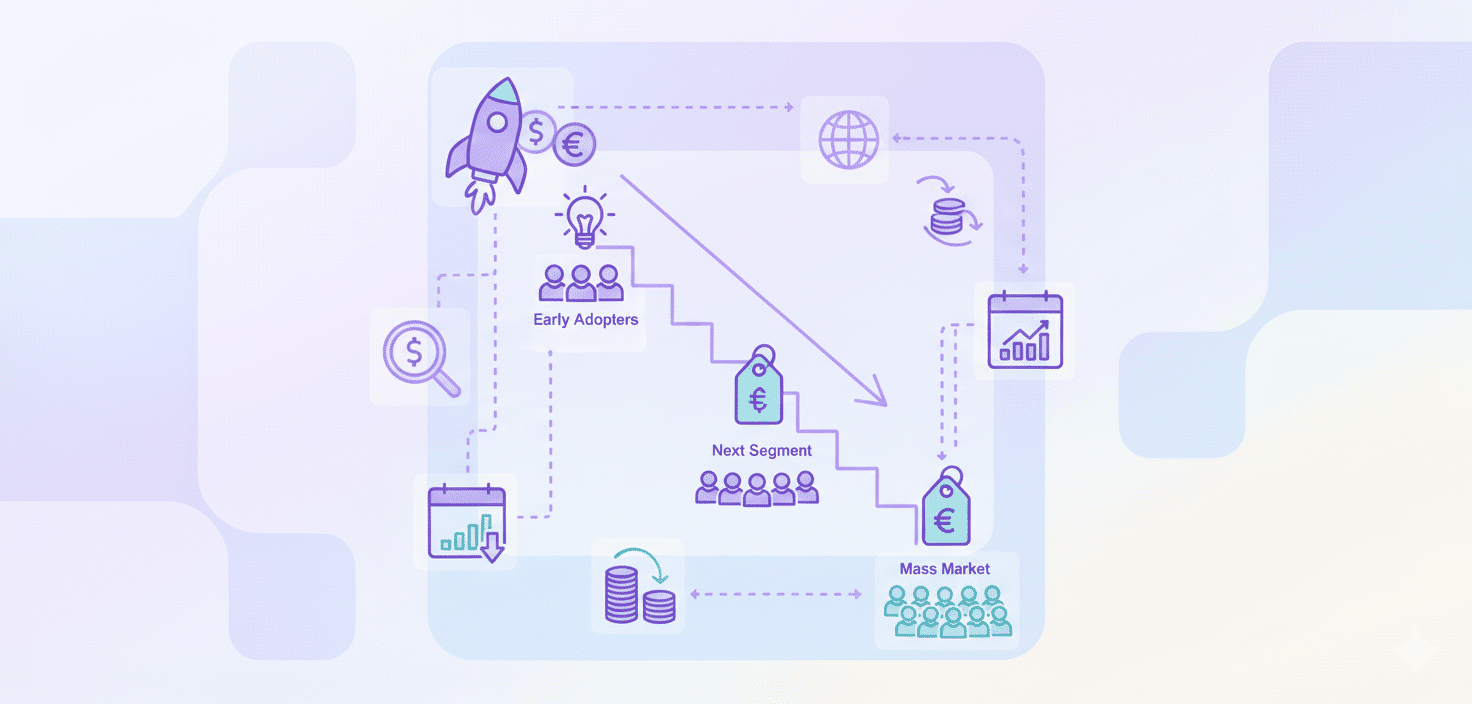定价策略
什么是SaaS撇脂定价?

什么是SaaS撇脂定价?
SaaS 撇脂定价是一种定价策略,企业会:
- 最初对其软件收取高额费用。
- 随着时间的推移逐步降低价格。
目标:
- 以期从那些愿意支付更高价格的早期采用者那里获得尽可能多的收入。
- 以塑造与新颖性、独特性和发展相关的品牌形象。
典型的 SaaS 应用场景:
- 采用基于功能的分级定价,其中首先提供价格更高的套餐。
- 提供打包服务而非快速降价。
如何在SaaS中实施撇脂定价?
需要采取的步骤如下:
- 对您的客户进行一些研究:了解他们的需求、痛点和财务能力。
- 评估您产品的价值: 确保它足够独特或创新,以证明更高的价格是合理的。
- 采用有计划的策略:
- 从高价值商业客户开始。
- 逐步扩展到价格更实惠的较小市场。
4) 利用定价工具: 撇脂定价曲线计算器和竞争对手响应模拟器有助于模拟收入曲线。
示例:
由人工智能驱动的营销自动化SaaS可能:
- 针对大型企业推出高级计划。
- 之后为中小企业发布更简单、成本更低的层级。
撇脂定价何时适用于SaaS?
当您的产品具有以下特点时,撇脂定价效果最佳:
- 具有新上市状态或创新特质。
- 包含显著优势或独特特征。
- 目标是愿意支付更高价格的早期采用者。
示例:
自动化复杂工作流程或引入新的AI驱动功能的SaaS平台可以为其早期高价提供依据。
如果满足以下条件,请考虑撇脂定价:
- 您已在研发上投入巨资。
- 您计划在未来发布新产品,这将重新启动撇脂周期。
哪些因素决定SaaS价格撇脂的适用性?
影响适用性的关键因素包括:
- 产品独特性: 区别于竞争对手的创新。
- 感知价值: 强大到足以支持高溢价。
- 市场差异化: 引人注目的品牌或卓越的功能。
- 客户体验: 优质的支持和客户引导。
|
因素 |
重要性 |
示例 |
|
产品创新 |
证明初期高价的合理性 |
AI驱动的分析平台 |
|
客户感知 |
建立独家性和信任 |
“企业级”品牌形象 |
|
市场竞争 |
影响策略的持久性 |
独特技术减少直接竞争对手 |
|
研发成本 |
更快地收回投资 |
高初期利润率覆盖成本 |
产品市场契合度如何影响SaaS价格撇脂?
以下几点值得考虑:
- 强大的PMF意味着客户明确重视您的产品并愿意为此付费。
- 它支持更高的初始定价,并能促使早期用户更顺畅地采用。
- 良好的PMF(产品市场契合度)带来:
- 自然增长(推荐和口碑)。
- 高留存率,巩固价格完整性。
专业提示:
持续监测反馈,并随着PMF的演变调整定价,以保持与客户价值的一致性。
如何通过价格撇脂策略优化SaaS收入?
- 溢价启动: 以高价推出,瞄准对价格不那么敏感的客户。
- 逐步降低价格: 将覆盖范围扩展到对成本更敏感的细分市场。
- 监测数据: 跟踪转化率、客户反馈和客户流失。
- 使用分析工具:
-
- AI定价系统。
- 撇脂定价曲线计算器。
示例:
通过 细分客户 并采用撇脂定价,Atlassian 调整了其定价结构,这可能与产品生命周期内的收入波动有关。
SaaS 撇脂定价的优缺点是什么?
SaaS撇脂定价具有以下优点和缺点:
优点:
- 从早期采用者那里获取最大收入。
- 建立高端品牌形象。
缺点:
- 易受竞争对手削价竞争的影响。
- 降价后可能会疏远早期购买者。
- 如果客户期待折扣,会促使购买延迟。
- 在竞争激烈的市场中,长期高价是不可持续的。
- 可能与免费增值模式冲突,或损害信任。
SaaS 有哪些替代定价策略?
SaaS公司还可以采用:
- 免费增值 或 免费试用 – 快速吸引大量用户。
- 按使用量定价 – 客户按其消耗量付费。
- 基于用户的定价 – 根据用户数量提供折扣(例如:Slack)。
- 分层定价 – 针对不同的功能集提供不同的方案。
- 按功能定价 – 按模块或功能收费。
- 产品捆绑 – 将工具组合起来以实现 交叉销售.
- 高低定价 – 通过临时折扣来促进销售。
采用撇脂定价策略的SaaS公司示例
- Salesforce:推出了高端CRM计划,并随后降低了入门级定价。
- Adobe Creative Cloud:最初推出时采用高端订阅模式,随后扩展到灵活的计划。
最佳实践:
- 密切关注市场反应。
- 细分客户群,以实现受控的价格调整。
- 保持开放和坦诚的沟通,以维护客户信任。
结论
撇脂定价,若能深思熟虑地实施,可有效影响SaaS定价策略。企业通过整合创新、数据驱动的调整以及公开的价值沟通,既能获得早期收益,又能为长期增长奠定基础。
准备好开始了吗?
我们也曾经历过您的挑战。让我们分享18年的经验,助您实现全球梦想。